

Lesson Plan: Phonemic Awareness, Say it and Move It. Most people have never heard of a part of the reading process called Phonemic Awareness.
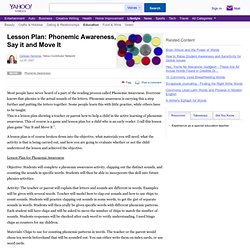
Everyone knows that phonics is the actual sounds of the letters. Phonemic awareness is carrying this a step further and putting the letters together. Some people learn this with little practice, while others have to be taught. This is a lesson plan showing a teacher or parent how to help a child in the active learning of phonemic awareness. This of course is a game and lesson plan for a child who is an early reader. A lesson plan is of course broken down into the objective, what materials you will need, what the activity is that is being carried out, and how you are going to evaluate whether or not the child understood the lesson and achieved the objective. Alphabet BINGO - An activity for children to learn the alphabet. ABCya is the leader in free educational computer games and mobile apps for kids.
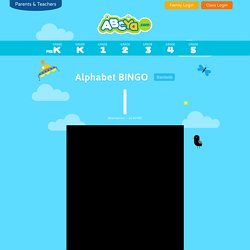
The innovation of a grade school teacher, ABCya is an award-winning destination for elementary students that offers hundreds of fun, engaging learning activities. Millions of kids, parents, and teachers visit ABCya.com each month, playing over 1 billion games last year. Apple, The New York Times, USA Today, Parents Magazine and Scholastic, to name just a few, have featured ABCya’s popular educational games. ABCya’s award-winning Preschool computer games and apps are conceived and realized under the direction of a certified technology education teacher, and have been trusted by parents and teachers for ten years. Syllable, Beginning Sounds and Rhyming Words. Into the Book: Teaching Reading Comprehension Strategies.
What is Phonemic Awareness? First of all, Phonemic awareness is not phonics.
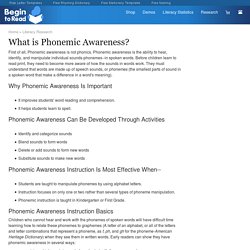
Phonemic awareness is the ability to hear, identify, and manipulate individual sounds-phonemes--in spoken words. Before children learn to read print, they need to become more aware of how the sounds in words work. They must understand that words are made up of speech sounds, or phonemes (the smallest parts of sound in a spoken word that make a difference in a word's meaning). Phonemic awareness. Phonemic awareness is a subset of phonological awareness in which listeners are able to hear, identify and manipulate phonemes, the smallest units of sound that can differentiate meaning.
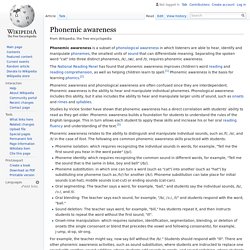
Separating the spoken word "cat" into three distinct phonemes, /k/, /æ/, and /t/, requires phonemic awareness. Phonemic awareness and phonological awareness are often confused since they are interdependent. Phonemic awareness is the ability to hear and manipulate individual phonemes. Phonological awareness includes this ability, but it also includes the ability to hear and manipulate larger units of sound, such as onsets and rimes and syllables. Studies by Vickie Snider have shown that phonemic awareness has a direct correlation with students’ ability to read as they get older.
Phonemic Awareness. Phonemic Awareness vs. Phonological Awareness Explained. What is Phonemic Awareness? Phonological Awareness. Phonemic Awareness: Concepts and Research. Concepts and Research Phonemic Awareness (PA) is: the ability to hear and manipulate the sounds in spoken words and the understanding that spoken words and syllables are made up of sequences of speech sounds (Yopp, 1992; see References). essential to learning to read in an alphabetic writing system, because letters represent sounds or phonemes.
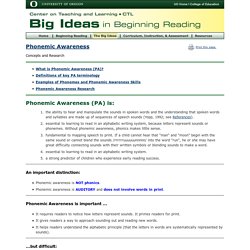
Without phonemic awareness, phonics makes little sense. Fundamental to mapping speech to print. If a child cannot hear that "man" and "moon" begin with the same sound or cannot blend the sounds /rrrrrruuuuuunnnnn/ into the word "run", he or she may have great difficulty connecting sounds with their written symbols or blending sounds to make a word. essential to learning to read in an alphabetic writing system. a strong predictor of children who experience early reading success. Phonemic Awareness. Phonemic Awareness Information and Activities. Phonemic Awareness - Pre Reading Skills - Reading Skills Pyramid. Phonemic awareness is the understanding that words are made up of sounds which can be put together in different ways to make different words.

Simply put, phonemic awareness is the moment a child realizes that if the "b" in "bat" is changed to a "c", then the word becomes "cat. " Phonemic awareness is a critical pre-reading skill which is often overlooked. And while each child is different, most learn to read following a similar sequence. Many are able to continue with no trouble when steps are missed, but others may have difficulty later because they didn't make the connection. Learning to read should be an exciting time, and with Time4Learning, it can be. For more information, check out our curriculum demos or early reading lesson plans for kindergarten, first, and second grade.
Training : UO DIBELS Data System. When children are first learning to blend, use examples with continuous sounds, because the sounds can be stretched and held.
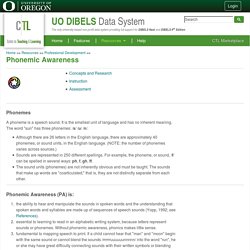
Example: "Listen, my lion puppet likes to talk in a broken way. When he says /mmm/ - /ooo/ - /mmm/ he means mom. " Non-example: "Listen, my lion puppet likes to talk in a broken way. When he says /b/ - /e/ - /d/ he means bed. " When children are first learning the task, use short words in teaching and practice examples. Patti's Activities. Phonological Awareness. Word Awareness Reading A-Z offers many resources for teaching word awareness.
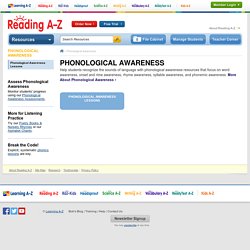
Materials that are well suited for "read-aloud" or "read to" instruction include alliterative Read-Aloud Books, Alphabet Chants, High-Frequency Word Books, Alphabet Books, and Shared Reading Books. Phonological awareness. Overview[edit] Phonological awareness involves the detection and manipulation of sounds at three levels of sound structure: (1) syllables, (2) onsets and rimes, and (3) phonemes.
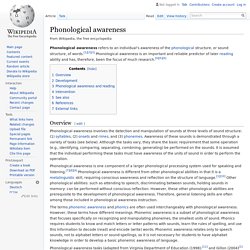
Awareness of these sounds is demonstrated through a variety of tasks (see below). Although the tasks vary, they share the basic requirement that some operation (e.g., identifying, comparing, separating, combining, generating) be performed on the sounds. It is assumed that the individual performing these tasks must have awareness of the units of sound in order to perform the operation. Phonemic Awareness. Phonological Awareness. Phonemic Awareness. Phonological Awareness: Instructional and Assessment Guidelines.
By: David J.
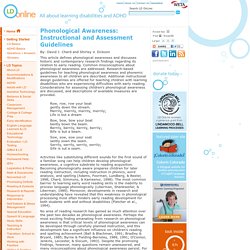
Chard and Shirley V. PHONEMIC AWARENESS. Phonological Awareness Lessons. Phonemic Awareness. Phonemic Awareness: An Important Early Step in Learning To Read. Relation To The "Great Reading Wars" Phonological awareness and its role in beginning reading has the potential to confound supporters at both extremes of the whole language vs. phonics "debate" over reading instruction. Regardless of instructional technique, phonological awareness is an essential element for reading progress (Griffith and Olson, 1992).
In another study, Griffith et al. (1992) found that children with high phonemic awareness outperformed those with low phonemic awareness on all literacy measures, whether they were taught using a whole language approach or traditional basal instruction. Whole language advocates need to admit that not all children develop this necessary ability simply through immersion in a print-rich environment, and that some children will need direct instruction in phonological awareness. Back to the Table of Contents. PA Final Part1. Phonological Awareness. Upon completion of this section, you will: Phonemic Awareness Activities. Phonological Awareness Activities Packet (Aligned to Common Core) It has taken a while but we have finally completed our Phonological Awareness Activities Packet.
This packet has been a huge undertaking but we wanted to accomplish a few things with it: Align the phonemic awareness activities on this page below with the Common Core Standards.Create new phonemic awareness activities for the standards we did not have existing activities for.Put all the activities in one download! What we ended up with is a 58 page Phonological Awareness Activities Download.The file was so large that we could not upload it to our Download Central Page so we placed it in Katie's TpT Store. Here are some sample pics for you. This is our favorite part about the new download! Head on over to Katie's TpT Store to purchase this packet for just $3 or keep scrolling down for all of our FREE phonemic awareness activities.
Reading Rockets: Launching Young Readers . Sounds & Symbols . Helpful Articles . Phonemic Awareness. Article 1: Phonemic Awareness Every time you chant along to a favorite children's rhyme or read aloud from a book like One Fish, Two Fish, Red Fish, Blue Fish by Dr. Seuss, you are helping children develop phonemic awareness. Notice the rhyme in this excerpt: Hop! Hop! What it means When children identify that the words hop, Yop, and top rhyme, they are developing phonemic awareness.
Marilyn Jager Adams outlines five basic types of phonemic awareness tasks tutors can perform with children (Adams, 1990). 1. Listen for the two words that rhyme in a string of words like cat, boy, bat. Definition of Phonemic by Merriam-Webster. Phonemic Awareness. A phoneme is the smallest unit of sound in a spoken word that makes a difference in the word's meaning. For example, changing the phoneme /o/ in the word dog to the phoneme /i/ changes the word dog to dig. Phonemic awareness is the ability to notice, think about, and work with the individual sounds, or phonemes, in spoken words.
Thesaurus - Phonemic Awareness. Syllable, Beginning Sounds and Rhyming Words. Phonemic Awareness: Books. Irvine Unified School District: Phonemic Awareness Activities for 4-5-6 Year Olds.